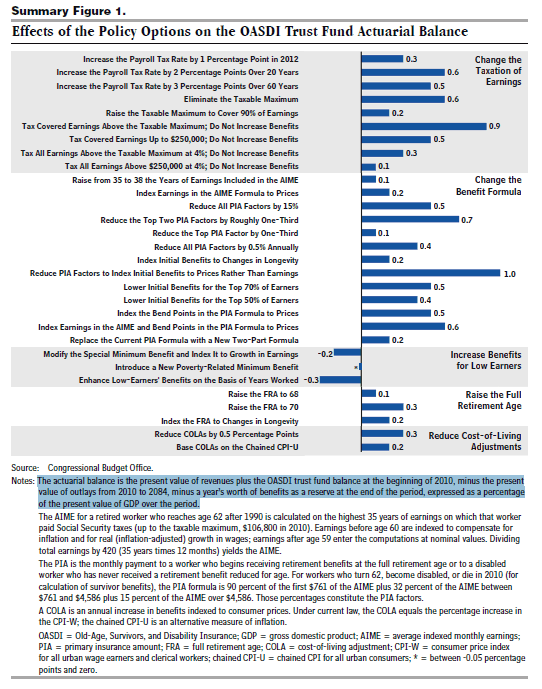Several people have written asking about specific Social Security tweaks and the relative magnitude of the ‘fix’ provided by them (yesterday’s post; earlier today). Below is a summary table from the July 2010 CBO report on Social Security reform options. The benefit of this report is that it shows different options (increase tax rate, increase wage to which the rate is applied, different ways to cut benefits, either directly or by indexing benefits, etc.) each run one at a time. Summary Figure 1, from page XI of the report provides a useful overview of the different options and their relative effect on the actuarial balance of the OASDI trust fund balance, defined as follows: “present value of revenues plus the OASDI trust fund balance at the beginning of 2010, minus the present value of outlays from 2010-2084, minus a year’s worth of benefits as a reserve in 2085, expressed as a percentage of the present value of GDP from 2010-84.”
The shortfall for Social Security (degree to which now promised benefits are larger than expected revenue) is around 0.9% of GDP over the period 2010-84. That is the amount (0.9% of GDP over this period) that must be made up one way or another. The table below shows various fixes, also expressed as percent of GDP over the same period. There are a variety of options, and certainly a mix of them, that could easily shore up Social Security for the next 75 years. My preference would be to enhance minimum benefits, do something to address the problem of people outliving their private savings given the increasing life span, and then assume that a mixture of tax increases and benefit cuts for high income retirees will be necessary to get to a plan that could pass the House, the Senate and be signed by the President. My strongest preference is not for a particular set of tweaks, but that we pick one/some of them and move ahead now. The barriers to doing so are political, not technical. Later, I will write a bit more on how I see Social Security reform fitting into the overall budget debate and long range health care reform agenda.

